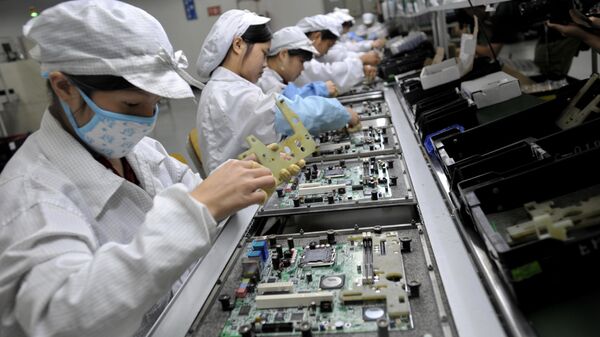Workers at a Foxconn plant in India have started assembling and testing Apple’s iPhone X in recent months as the US-China trade war shows no sign of ending, Bloomberg reports.
Foxconn is a Taiwan-headquartered company known for the production of various Apple products such as the iPhone, iPad and iPod.
Touching upon Foxconn’s plans to move phone production to India, Josh Foulger, head of the company’s India operations, told Bloomberg that “it’s a good business principle not to put all your eggs in a single basket.”
“We have to find viable and reliable alternatives. Obviously the alternative location has to be competitive. We can’t put a factory in Mexico for manufacturing mobiles. It might have worked 10 years ago, it just won't work today,” Foulger said.
He added that Foxconn hopes to manufacture Apple phones’ displays and printed circuit boards locally; additionally, the company is considering manufacturing other products, including Amazon Echo speakers, at its Indian plants.
“Until now, India has made for India. Soon India will make for the world,” Fougler claimed.
At the same time, he admitted that implementing all this will be a formidable task.
“I can twirl my moustache and say, ‘India can replicate China’. The reality is that we have shortcomings,” he said.
The interview comes after reports emerged that Apple was making moves to shift production outside of China, should the Beijing-Washington trade war escalate further.
Nikkei Asian Review, in turn, reported that Apple has been sizing up the costs of moving between 15% and 30% of all iPhone production out of China as it prepares for a restructuring of its supply chain.
Earlier, semiconductor division chief Young Liu of Foxconn reportedly told investors that 25 percent of its production capacity is already outside mainland China.
US-China Tariff Spat Exacerbates
Meanwhile, Washington announced it would raise tariffs on $250 billion worth of Chinese goods from 25 to 30 percent from 1 October, and that US duties would be raised from 10 percent to 15 percent on another $300 billion worth of Chinese goods starting on 1 September.
This came in retaliation against Beijing’s announcement that tariffs ranging from 5 to 10 percent would be slapped on $75 billion worth of US goods, with some taking effect on 1 September and others on 15 December.
The US and China have been embroiled in a tit-for-tat trade spat since mid-2018, when the Trump administration slapped a 25 percent tariffs on $50 billion worth of Chinese goods. Since then, the two countries have hit one another with several more rounds of back-and-forth tariffs.


